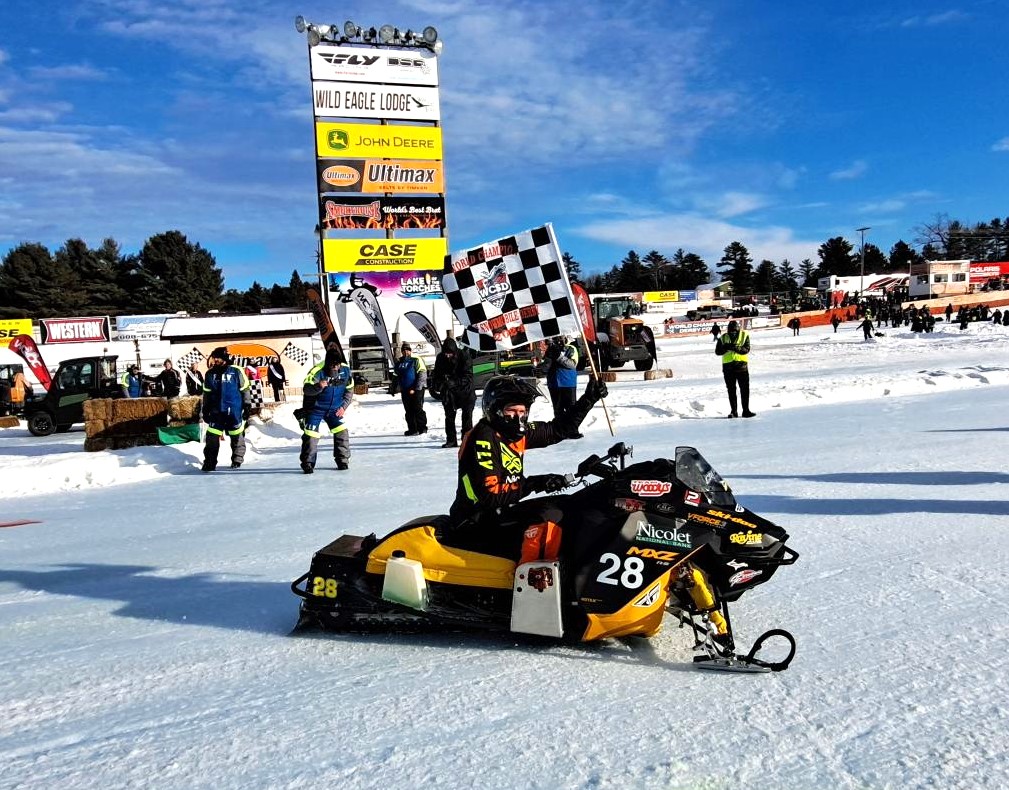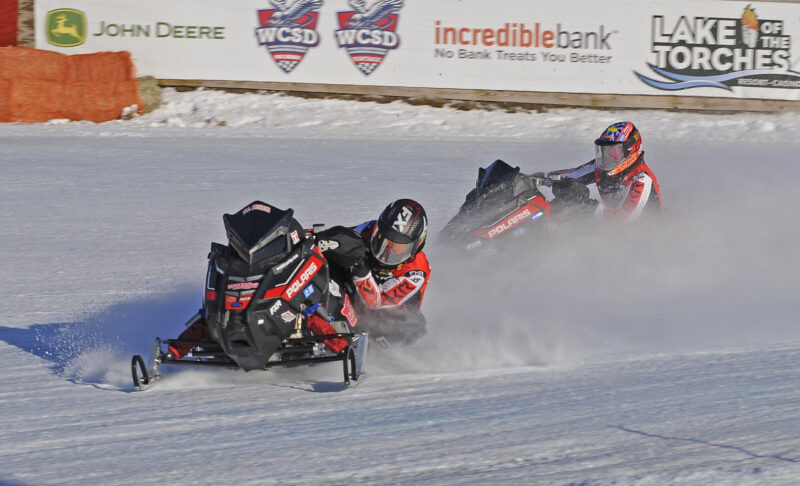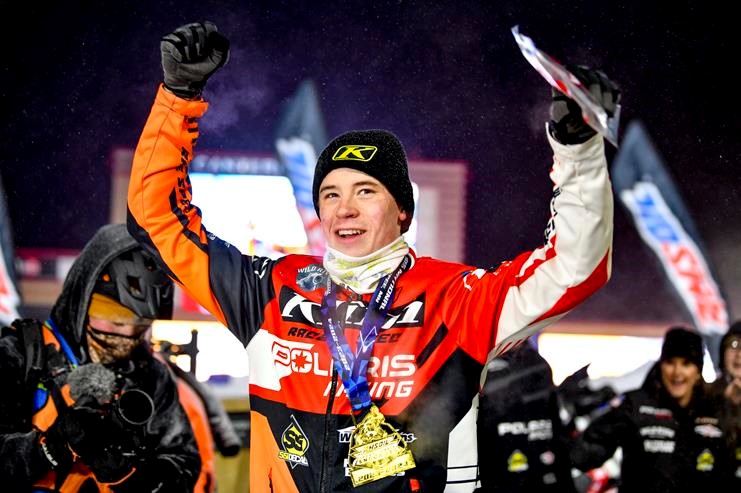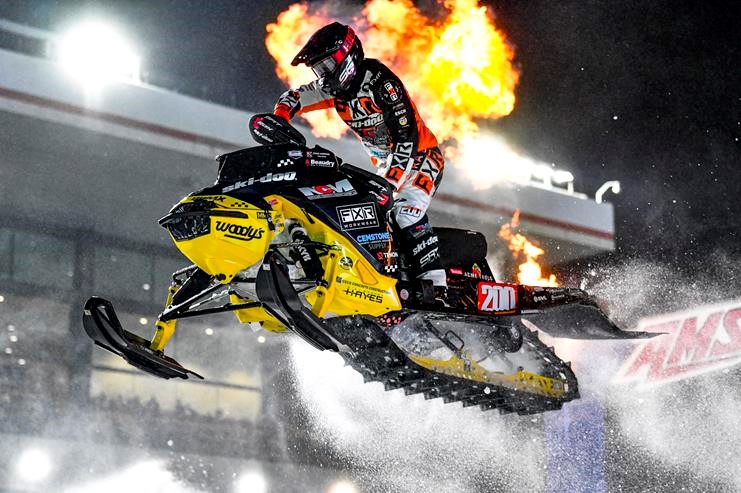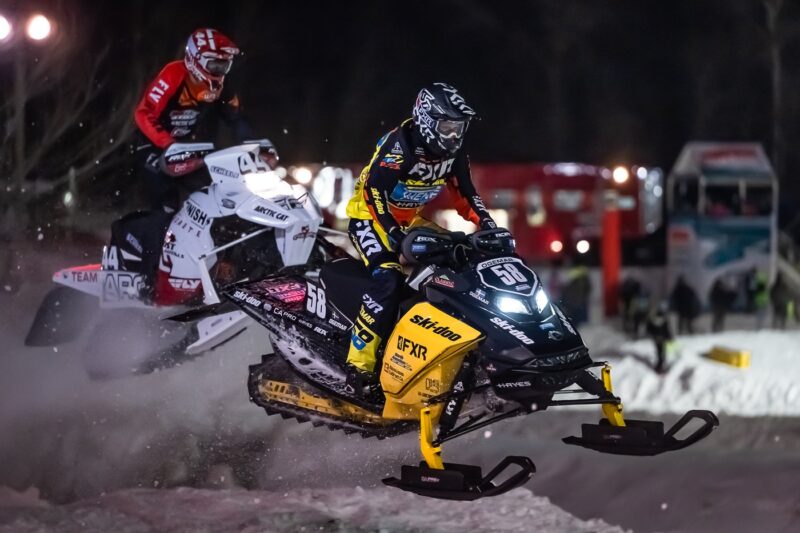
This year, the fastest guy all weekend actually won the race.
Matt Schulz of Wausau, Wisconsin, has been considered the odds-on favorite for virtually every year since he won his first Eagle River World Championship in 2010. In those years, he has often been the fastest qualifier, he has won the vast majority of his qualifying races, and he has led a ton of laps in the finals. But each year it seems something odd would happen and he would be denied his second title on the famed banked ice oval track in Eagle River, Wisconsin.
“I just don’t have any luck at this place, I guess,” Schulz said several times Friday and Saturday.
In Sunday’s final, held under blue skies in frigid conditions, Schulz left no doubt. He led every lap, was not phased by multiple restarts and was never seriously challenged en route to a dominating and emotional victory. He will have his name inscribed into history and placed on the Snow Goer Cup for a second time.
The Road To The Final
Through qualifying races on Friday and Saturday, a star-studded and super-fast group of 10 racers earned front-row starting positions for Sunday’s 3 p.m. World Championship final. Schulz won every one of his races along the way except for one – a controversial Friday Night Thunder race in which many thought that eventual winner Travis MacDonald may have jumped the gun on a late restart.
Joining Schulz on the front row was a big group of impressive racers. It included many young guns riding on top-notch equipment – including Blaine Stephenson, considered by many to have the weekend’s second-fastest sled to Schulz, along with Gunnar Sterne and Matt Ritchie, each on their quickest sleds ever. It also included some former World Champs with strong equipment, including defending champ Cardell Potter and 2012 title holder Nick Van Strydonk. Friday night winner MacDonald was there, as was veteran Dustin Wahl, who has won everywhere except at Eagle River in his storied career, and the always strong Joey Fjerstad. The dark horse was 18-year-old Quebec racer Steven Marquis, racing in his first W.C.
The field was filled out with a last-chance qualifier race Sunday afternoon, when former vintage champion Glen Hart and eastern racer Mike Hakey advanced by finishing first and second while the rest of the field was eliminated, including the sport’s only four-time champion P.J. Wanderscheid, who is strongly considering retiring from the sport.
That group was lined up in front of an impressive crowd, considering the sub-zero wind chills, at 3 p.m. Sunday, and after the usual Derby pomp and circumstance, the racers fired their engines for a run at history.
The First 10, er, 9
As has been the recent tradition, the big race would be run in split fashion, with 10 initial laps of green flag racing, then a 10 minute pit stop, followed by a restart and 20 more laps to determine a winner.
On green, Schulz blasted into the lead from his second-from-the-inside starting position, getting to and through the first set of turns cleanly with enough of a gap where nobody could even rub him. He blasted down the backstretch on his yellow LRM-powered Ski-Doo mod with Potter directly in tow, then Gunnar Sterne and then a big pack of racers bunched together.
Not part of that crowd was Stephenson – the sled that was fast and foolproof all weekend bogged heavily on the starting line and sounded sick as it groaned and slowly gained speed. A pre-race pick of many fans, his day wasn’t starting well at all.
While the rest of the pack started sorting itself out in very heavy snowdust, Schulz had a clean track in front of him and quickly opened an impressive lead. Sterne ran fourth early but soon succumbed to the pressure of a charging Van Strydonk, with MacDonald running fifth early, then Wahl.
By lap eight, Schulz has already opened a lead of almost a full straight-away over Potter, while Van Strydonk was putting heavy pressure on Sterne for third. But in another two laps, chaos would briefly take hold of the track.
Schulz took the checkered flag, theoretically marking the end of the first 10-lap segment and the top four or so followed him across the line. But then that flag was swapped out for a red flag because Glen Hart had crashed on the exit of turn two, while he was on lap 9. That left racers back in the pack coasting toward the finish line.
And that touched off an odd and, for some, emotional moment. Normally, after the 10 laps, the racers pull on the front stretch for their 10-minute tuning period in front of the fans, and the sleds were parked and began to be surrounded by the teams’ wrenchers. But the folks in charge said that only 9 laps had technically been finished, even though the leader took the checkered. So, it was first announced, all of pit crew members and their gear had to get off of the track and the racers had to line up for a restart to run one lap before the mandatory stop.
That seemed highly unusual to many racers and many rowdy fans, who loudly questioned the logic. So, after some deliberation, the race officials announced they would instead add a lap to the planned second segment of the race – making it 21 laps. That seemed to appease the fans, but some racers got very hot under the collar. Some, in fact, even threatened to leave the race.
In the end, race officials essentially cancelled the lap – and the final segment would be a true 20 laps.
During the pit period, the crews swapped out runners, cooled engines and generally spun wrenches and tuned and tightened. But Marquis’ day was over – he was towed off the track because the bolt holding his lower right A-arm broke and that A-arm was dragging on the ground.

The Run To The Checkered
So, 11 sleds lined up for the final 20 laps in this order: The first three were the Ski-Doos of Schulz, Potter and Sterne, followed by the Polaris sleds of Van Strydonk and Ritchie. MacDonald’s Ski-Doo was sixth, then the Polaris sleds of Wahl and Stephenson, Hakey’s Ski-Doo, Fjerstad’s Polaris and Hart’s Ski-Doo.
On green the 102 of Stephenson bogged and groaned mightily again, moving him to last, while Schulz again got a monster holeshot and began to immediately pull away. Sterne blasted into second ahead of Potter, but Potter would get the runner-up spot back a lap later, using a low line to get underneath the Illinois-based racer and then pulling away to chase Schulz. Ritchie moved up to fourth but was under heavy pressure from Van Strydonk. Within four laps, Schulz already had a half-straight lead over Potter again and was expanding it. In fact, Schulz’s only problem of the race was on about lap 16, when he was lapping the No. 16 of Fjerstad and Fjerstad got a bit crossed up and almost drifted into the side of the leader.
Van Strydonk was the driver on the move, moving past Sterne for third. But deeper in the pack the field was narrowing, as drivers pulled to the inside of the track to get out of the way for a variety of reasons. Dustin Wahl had his sled break while he was high in turn two, however, so he drifted to the top of the track and that brought out the red flag.
Stephenson (scored 11th) only made it 13 laps – his crew said they thought his engine probably ate one of its reeds, causing the engine to fail. Later, though, rumor had it that the problem was ignition related. MacDonald (10th) only made it to lap 18 and ended his race for an unusual reason – a really, really bad case of arm pump in his forearms which made it impossible for him to drive. “His arms are completely locked up” one crew member said. Ritchie (9th) pulled off after 20 laps because he couldn’t see – his goggles were completely frozen over. Wahl’s sled (8th) was put on a cart and pulled off the track with 21 laps in the books.
For the last eight laps, the sleds were lined up in this order: Schulz, Potter, Van Strydonk, Sterne, Hakey, Fjerstad and a relatively slow-moving Hart, who was staying in the low line and putting in laps while trying to stay out of the way of the faster sleds.
On green, Schulz again launched hard and again immediately opened a lead, but it was Potter’s turn to experience a bad bog – he lost second and drifted toward the back of the pack. His sled quickly recovered, though, and he soon jumped up to fifth.
Sterne therefore grabbed second, with Van Strydonk third and Hakey fourth, but both Potter and Van Strydonk were on the charge. About three laps later Van Strydonk grabbed second away from Sterne while Potter moved past Hakey using a low line for fourth. A couple of laps later, Potter used a similar move to get past Sterne and into third.
Up front, Schulz was again unchallenged and charged in clean air toward a waving checkered flag. Van Strydonk kept him in his sights, though, and finished 2.346 seconds behind in second, with Potter another 5.034 seconds behind in third. Another 7 seconds passed before Sterne came across the line in fourth, with Hakey the last sled on the lead lap, 8.3 seconds behind Sterne. Fjerstad was sixth, one lap down, with Hart ending up 7th.
The Celebration
After taking the checkered flag the winner pulled onto the backstretch and was mobbed by his crew, to the point where Schulz and part of the crew ended up on the ground in a huge celebration.
“I can’t believe it!” Schulz exclaimed when he came up to the front stretch and was surrounded by reporters. “I’ve been so close every year since 2010. It got to the point where I started to wonder if we just got lucky in 2010, and I didn’t know if we’d ever do it again.”
Indeed, Schulz led most of the final last year but his engine faded late and then he blew a drive belt. In 2014 he finished second, a couple of seconds behind Chartier. In 2013, he finished .95 seconds behind Chartier, and in 2012 Schulz led 24 of 25 laps but was passed by Van Strydonk at the finish line, losing by .025 seconds.
“We were really, really good when we unloaded, and were really good all weekend except for Friday night, when we changed our torque converter,” Schulz explained. “I didn’t sleep well last night – for some reason I was really, really nervous. I knew I had a fast sled.”
Asked his strategy, he said, “I wanted to run the high line and stay out of the rough stuff.” He praised his team, including his longtime primary wrench and mentor, his uncle and 1993 World Champion Al Fenhaus. He was driving a new chassis built by 1999 and 2000 World Champion Mike Houle, and also has help from 1994 and 1995 champ Dale Loritz, among others. He definitely had the fastest sled – his fastest lap of 17.937 seconds was way quicker than any other competitor – Potter’s best lap was the closest at 18.285 seconds.
Van Strydonk got faster all weekend on a new sled that was built in the last two weeks. “It’s been a great sled all weekend and we’re still learning,” Van Strydonk said. “It was cold out today and that helped us. It was a rough track but I like it tough – that works to my advantage, I train for this all year long.”
Potter saw any chance he had at a repeat go up in smoke on the final restart.
“The motor just sputtered and popped and didn’t go anywhere,” Potter said. But did he have the ability to keep up with Schulz, he was asked.
“It would have been tough, maybe I could have kept close to him if I would have gotten a good restart,” Potter said.
To see photos and pre-race odds of the front row racers, click here.

